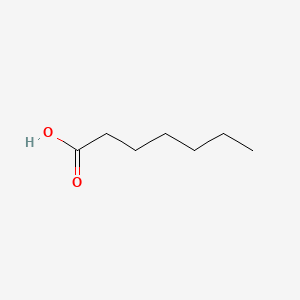| MeSH term | MeSH ID | Detail |
|---|---|---|
| Olfaction Disorders | D000857 | 17 associated lipids |
| Byssinosis | D002095 | 11 associated lipids |
| Mitochondrial Diseases | D028361 | 25 associated lipids |
HEPTANOIC ACID
HEPTANOIC ACID is a lipid of Fatty Acyls (FA) class. Heptanoic acid is associated with abnormalities such as Dehydration. The involved functions are known as Process, Anabolism, inhibitors, Oxidation and fatty acid oxidation. The related lipids are Heptanoates and undecanoic acid.
Cross Reference
Introduction
To understand associated biological information of HEPTANOIC ACID, we collected biological information of abnormalities, associated pathways, cellular/molecular locations, biological functions, related genes/proteins, lipids and common seen animal/experimental models with organized paragraphs from literatures.
What diseases are associated with HEPTANOIC ACID?
HEPTANOIC ACID is suspected in Dehydration and other diseases in descending order of the highest number of associated sentences.
Related references are mostly published in these journals:
| Disease | Cross reference | Weighted score | Related literature |
|---|
Possible diseases from mapped MeSH terms on references
We collected disease MeSH terms mapped to the references associated with HEPTANOIC ACID
PubChem Associated disorders and diseases
What pathways are associated with HEPTANOIC ACID
There are no associated biomedical information in the current reference collection.
PubChem Biomolecular Interactions and Pathways
Link to PubChem Biomolecular Interactions and PathwaysWhat cellular locations are associated with HEPTANOIC ACID?
There are no associated biomedical information in the current reference collection.
What functions are associated with HEPTANOIC ACID?
Related references are published most in these journals:
| Function | Cross reference | Weighted score | Related literatures |
|---|
What lipids are associated with HEPTANOIC ACID?
Related references are published most in these journals:
| Lipid concept | Cross reference | Weighted score | Related literatures |
|---|
What genes are associated with HEPTANOIC ACID?
There are no associated biomedical information in the current reference collection.
What common seen animal models are associated with HEPTANOIC ACID?
There are no associated biomedical information in the current reference collection.
NCBI Entrez Crosslinks
All references with HEPTANOIC ACID
Download all related citations| Authors | Title | Published | Journal | PubMed Link |
|---|---|---|---|---|
| Di Cagno R et al. | Duodenal and faecal microbiota of celiac children: molecular, phenotype and metabolome characterization. | 2011 | BMC Microbiol. | pmid:21970810 |
| Gonzales GF | Ethnobiology and Ethnopharmacology of Lepidium meyenii (Maca), a Plant from the Peruvian Highlands. | 2012 | Evid Based Complement Alternat Med | pmid:21977053 |
| Mori H and Iwahashi H | Formation of 7-carboxyheptyl radical induced by singlet oxygen in the reaction mixture of oleic acid, riboflavin and ferrous ion under the UVA irradiation. | 2011 | J Clin Biochem Nutr | pmid:21980232 |
| Wang PC et al. | Sesquiterpenoids and lignans from the roots of Valeriana officinalis L. | 2011 | Chem. Biodivers. | pmid:22006719 |
| Haskå L et al. | A water-soluble fraction from a by-product of wheat increases the formation of propionic acid in rats compared with diets based on other by-product fractions and oligofructose. | 2011 | Food Nutr Res | pmid:22022302 |
| Cheema S et al. | Exploiting metagenomic diversity for novel polyhydroxyalkanoate synthases: production of a terpolymer poly(3-hydroxybutyrate-co-3-hydroxyhexanoate-co-3-hydroxyoctanoate) with a recombinant Pseudomonas putida strain. | 2012 | Bioresour. Technol. | pmid:22071242 |
| Clarke JM et al. | Butyrate delivered by butyrylated starch increases distal colonic epithelial apoptosis in carcinogen-treated rats. | 2012 | Carcinogenesis | pmid:22080572 |
| Brechbühl J et al. | Imaging pheromone sensing in a mouse vomeronasal acute tissue slice preparation. | 2011 | J Vis Exp | pmid:22157638 |
| Wang Y et al. | Fatty acid composition and antioxidant activity of tea (Camellia sinensis L.) seed oil extracted by optimized supercritical carbon dioxide. | 2011 | Int J Mol Sci | pmid:22174626 |
| Bignetti E et al. | The amelioration of olfactory acuity upon sexual maturation might affect food preferences. | 2009 | Nutrients | pmid:22253964 |
